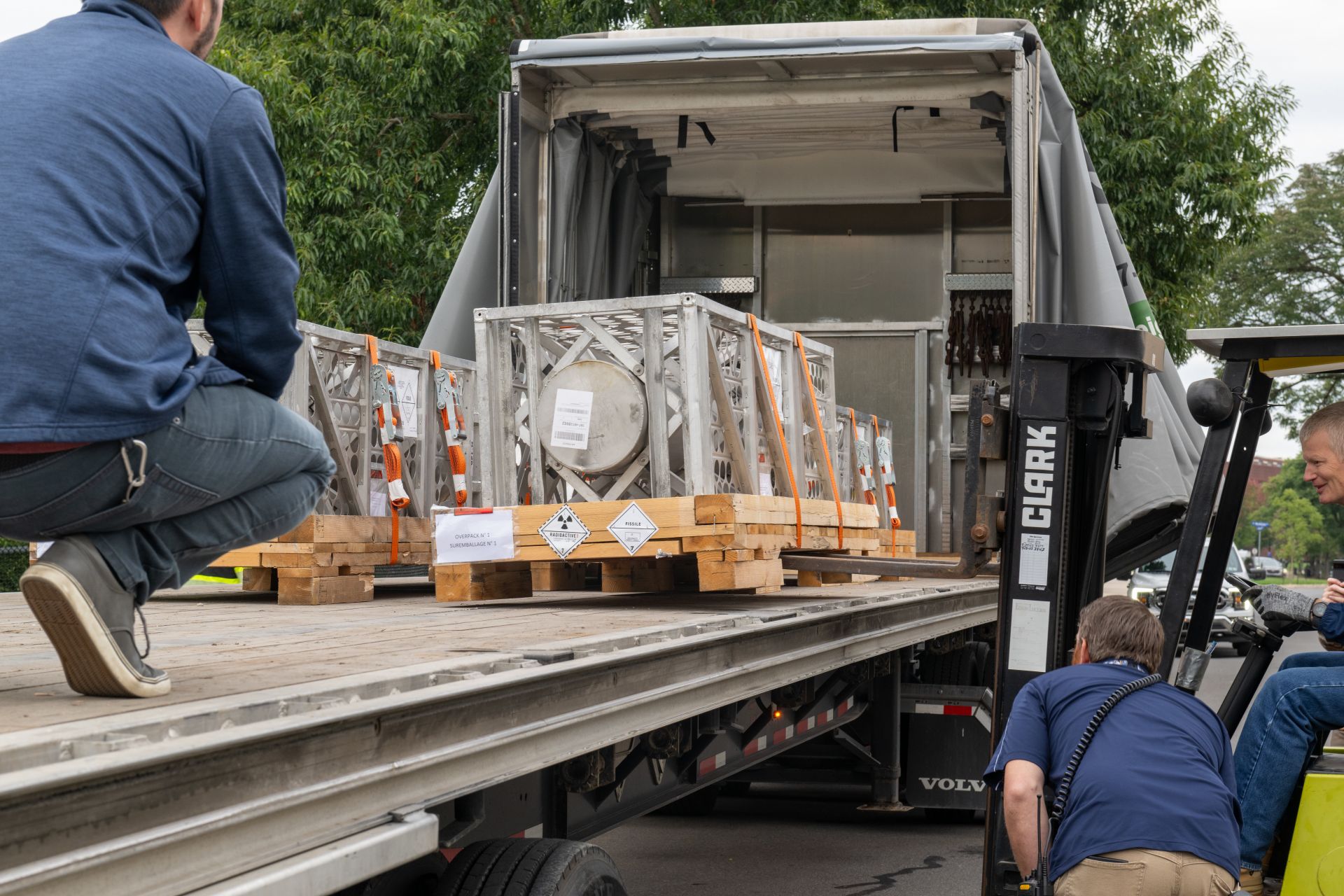The Integrated Effects Test at TerraPower’s laboratory in Everett, Wash. (Photo: Southern Company/TerraPower)
Southern Company, TerraPower, and Core Power (a U.K.-based firm focused on developing nuclear technologies for the maritime sector) have commenced pumped-salt operations in the Integrated Effects Test (IET) facility, the Atlanta, Ga.-based utility announced Tuesday, marking another milestone in the development of TerraPower’s first-of-a-kind, Generation IV Molten Chloride Fast Reactor (MCFR).
From left, Rand Fisher, Cavendish Nuclear board member; Terry Michalske, board member; Rick Provencher, Cavendish Nuclear USA vice president; Bill Ostendorff, board chairman; and Michael Bond, board member. (Photo: Cavendish Nuclear USA)
Cavendish Nuclear (USA) Inc., a U.S.-incorporated, wholly owned subsidiary of Babcock International Group, has recently appointed its corporate board of directors and held its first board meeting at corporate headquarters in Arlington, Va.
The TRIGA shipment was received September 27. (Photo: Kate Myers/Penn State)
Penn State’s Radiation Science and Engineering Center (RSEC) has received the first new TRIGA fuel shipped to the United States since 2012, the university announced on September 28. The fuel reached University Park, Pa., on September 27 and is destined for RSEC’s Breazeale Reactor, the nation’s longest continuously operating university research reactor.
PUCT commissioner Jimmy Glotfelty leads the discussion at the Texas Advanced Nuclear Reactor Working Group’s first public meeting, on September 28. (Image: PUCT)
The Texas Advanced Nuclear Reactor Working Group—formed recently by the Public Utility Commission of Texas (PUCT) at the direction of Gov. Greg Abbott—hosted its first public meeting last Thursday to discuss the group’s organizational structure and outline a plan to turn Texas into a national leader in the use of advanced nuclear energy.
Comic books and cartoon characters began to be used to provide information and propaganda about nuclear weapons and energy in the 1940s. Items in the exhibition include True Comics #47 (1946), Bert the Turtle Says Duck and Cover (1951), The Mighty Atom, Starring Reddy Kilowatt (1959), and The H-Bomb and You (1955). (Photo: National Museum of Nuclear Science and History)
For many of us, the toys of our childhood leave indelible marks on our consciousness, affecting our long-term perceptions and attitudes about certain things. Hot Wheels may inspire a lifelong fascination with fast, flashy automobiles, while Barbies might shape ideas about beauty and self-image. For the generation who grew up during the Atomic Age—the post–World War II era from roughly the mid-1940s to the early 1960s—the toys, games, and entertainment of their childhoods might have included things like atomic pistols, atomic trains, rings with tiny amounts of radioactive elements, and comic books, puzzles, and music about nuclear weapons.
Romania’s Cernavoda Units 1 and 2. (Photo: Nuclearelectrica)
Canada will provide C$3 billion (about $2.2 billion) in export financing to Romania’s nuclear operator, Nuclearelectrica, in support of Canadian participation in the project to complete Units 3 and 4 at the Cernavoda nuclear plant, Canadian minister of energy Jonathan Wilkinson announced last week.
At the September 27 signing ceremony for the engineering services contract to build Poland’s first nuclear power plant are, from left, John Howanitz, president of Bechtel’s nuclear, security, and environmental global business unit; Westinghouse president and CEO Patrick Fragman; Polish government plenipotentiary for strategic energy infrastructure Anna Łukaszewska-Trzeciakowska; Polish prime minister Mateusz Morawiecki; U.S. ambassador to Poland Mark Brzezinski; assistant secretary of energy for international affairs Andrew Light; and Polskie Elektrownie Jądrowe president Mateusz Berger. (Photo: Bechtel)
Just one week after inking a consortium agreement to partner on the design and construction of Poland’s first nuclear power plant, Westinghouse Electric Company and Bechtel joined state-owned Polish utility Polskie Elektrownie Jądrowe (PEJ) in Warsaw on Wednesday for the signing of the project’s engineering services contract.
Upper-level view of Centrus’s HALEU cascade. (Photo: Centrus Energy)
The Nuclear Regulatory Commission is requesting comments on the regulatory basis for a proposed rule for light water reactor fuel designs featuring high-assay low-enriched uranium (HALEU), including accident tolerant fuel (ATF) designs, and on draft guidance for the environmental evaluation of ATFs containing uranium enriched up to 8 percent U-235. Some of the HALEU feedstock for those LWR fuels and for advanced reactor fuels could be produced within the first Category II fuel facility licensed by the NRC—Centrus Energy’s American Centrifuge Plant in Piketon, Ohio. On September 21, the NRC approved the start of enrichment operations in the plant’s modest 16-machine HALEU demonstration cascade.
Three of the USGS's critical minerals: (Left to right) A piece of native copper recovered by dissolution of the host rock (Photo: Jonathan Zander); A sample of praseodymium in a vial of argon (Photo: Jurii/Wikimedia Commons); A billet of high-enriched uranium that was recovered from scrap processed at the DOE’s Y-12 National Security Complex in Oak Ridge, Tenn (Photo: DOE).
Last year, the U.S. Geological Survey (USGS) released its 2022 list of 50 minerals that are essential to the function of our society, especially the economy and national security. Whether it’s indium for LCD screens and aircraft wind shielding, cobalt for iPhones, uranium for nuclear reactors and munitions, rare earth elements for wind turbine magnets, lithium for rechargeable batteries, or tantalum for electronic components, if we do not have an ample supply, bad things will happen.
Support from the government of Alberta for the Cenovus Energy SMR study was announced September 19 at the World Petroleum Congress in Calgary. From left are Laura Kilcrease, Alberta Innovates CEO; Rhona DelFrari, Cenovus chief sustainability officer and executive vice president, stakeholder engagement; Rebecca Schulz, minister of environment and protected areas; Justin Riemer, Emissions Reduction Alberta CEO; and Nathan Neudorf, minister of affordability and Utilities. (Photo: Government of Alberta)
Canada’s Alberta province is investing C$7 million (about $5.2 million) to help Cenovus Energy study how small modular reactors could be used in northern Alberta to decarbonize oil sands production and what additional information might be needed to pursue their regulatory approval.












